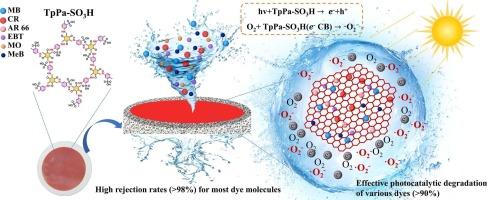用于高效染料分离的稳定表面改性 TpPa-SO3H/PVDF 膜显示出卓越的光催化降解性能
IF 6.3
2区 工程技术
Q1 ENGINEERING, CHEMICAL
引用次数: 0
摘要
在表面改性膜中充分利用 COFs 的独特特性是当前的研究重点。目前面临的挑战包括确保膜表面 COFs 分离层的稳定性以及开发 COFs 表面改性膜的环保型生产方法。本研究采用简单的室温合成方法制备了 TpPa-SO3H 的胶体水溶液。随后,利用真空过滤将 TpPa-SO3H 纳米片载入疏水性 PVDF 膜,得到 TpPa-SO3H/PVDF 膜。这种绿色高效的改性方法在膜表面形成了无缺陷的 TpPa-SO3H 层,表现出极佳的亲水性(水接触角为 50.8°)。在染料分离方面,TpPa-SO3H/PVDF 膜(F2)对大多数染料分子都有很高的截留率(98%),同时还具有良好的可回收性和过滤稳定性。即使暴露在极端酸性条件下,改性膜的分离性能也保持不变,显示出显著的耐酸性。此外,制备的改性膜还能有效光催化降解各种染料(90%),并具有出色的稳定性和可重复使用性。在三个周期的光催化自清洁性能测试中,改性膜表现出了显著的自清洁效果。这有效证明了其在光催化自清洁领域的潜力,展示了其在相关领域的能力和可行性。本文章由计算机程序翻译,如有差异,请以英文原文为准。

Stable surface-modified TpPa-SO3H/PVDF membrane for efficient dye separations showing excellent photocatalytic degradation performance
Fully utilizing the unique characteristics of COFs in surface-modified membranes is an ongoing research focus. Current challenges include ensuring the stability of the COFs separation layer on the membrane surface and developing environmentally friendly production methods for COFs surface-modified membranes. In this study, a simple room-temperature synthesis method was employed to prepare an aqueous colloidal solution of TpPa-SO3H. Subsequently, TpPa-SO3H nanosheets were loaded onto a hydrophobic PVDF membrane using vacuum filtration, resulting in the TpPa-SO3H/PVDF membrane. This green and efficient modification method yielded a defect-free TpPa-SO3H layer on the membrane surface, exhibiting excellent hydrophilicity (water contact angle of 50.8°). For dye separation, the TpPa-SO3H/PVDF membrane (F2) demonstrated high rejection rates (>98 %) for most dye molecules, along with good recyclability and filtration stability. Even after exposure to extreme acidic conditions, the separation performance of the modified membrane remains consistent, showcasing remarkable acid resistance. Furthermore, the prepared modified membranes exhibited effective photocatalytic degradation of various dyes (>90 %) as well as excellent stability and reusability. The modified membrane has shown significant self-cleaning effects in the three cycles of photocatalytic self-cleaning performance testing. This effectively demonstrates its potential in the domain of photocatalytic self-cleaning, exhibiting its capabilities and viability in the respective field.
求助全文
通过发布文献求助,成功后即可免费获取论文全文。
去求助
来源期刊

Journal of water process engineering
Biochemistry, Genetics and Molecular Biology-Biotechnology
CiteScore
10.70
自引率
8.60%
发文量
846
审稿时长
24 days
期刊介绍:
The Journal of Water Process Engineering aims to publish refereed, high-quality research papers with significant novelty and impact in all areas of the engineering of water and wastewater processing . Papers on advanced and novel treatment processes and technologies are particularly welcome. The Journal considers papers in areas such as nanotechnology and biotechnology applications in water, novel oxidation and separation processes, membrane processes (except those for desalination) , catalytic processes for the removal of water contaminants, sustainable processes, water reuse and recycling, water use and wastewater minimization, integrated/hybrid technology, process modeling of water treatment and novel treatment processes. Submissions on the subject of adsorbents, including standard measurements of adsorption kinetics and equilibrium will only be considered if there is a genuine case for novelty and contribution, for example highly novel, sustainable adsorbents and their use: papers on activated carbon-type materials derived from natural matter, or surfactant-modified clays and related minerals, would not fulfil this criterion. The Journal particularly welcomes contributions involving environmentally, economically and socially sustainable technology for water treatment, including those which are energy-efficient, with minimal or no chemical consumption, and capable of water recycling and reuse that minimizes the direct disposal of wastewater to the aquatic environment. Papers that describe novel ideas for solving issues related to water quality and availability are also welcome, as are those that show the transfer of techniques from other disciplines. The Journal will consider papers dealing with processes for various water matrices including drinking water (except desalination), domestic, urban and industrial wastewaters, in addition to their residues. It is expected that the journal will be of particular relevance to chemical and process engineers working in the field. The Journal welcomes Full Text papers, Short Communications, State-of-the-Art Reviews and Letters to Editors and Case Studies
 求助内容:
求助内容: 应助结果提醒方式:
应助结果提醒方式:


